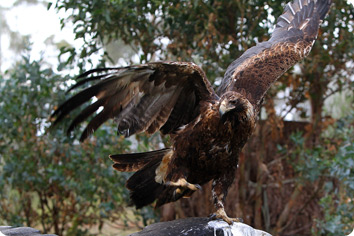The female Wedge-tailed Eagle (Aquila audax) weighs between 3 and 5.77 kg (6.6 and 12.7 lb), while the smaller males weigh 2 to 4 kg (4.4 to 8.8 lb). Length varies between 81 and 106 cm (32 and 42 in) and the wingspan typically is between 182 and 232 cm (6 ft 0 in and 7 ft 7 in). In 1930, the average weight and wingspans of 43 birds was 3.4 kg (7.5 lb) and 204.3 cm (6 ft 8 in). The same average figures for a survey of 126 eagles in 1932 were 3.63 kg (8.0 lb) and 226 cm (7 ft 5 in), respectively.
The largest wingspan ever verified for an eagle was for this species. A female killed in Tasmania in 1931 had a wingspan of 284 cm (9 ft 4 in), another female measured barely smaller at 279 cm (9 ft 2 in). Reported claims of eagles spanning 312 cm (10 ft 3 in) and 340 cm (11 ft 2 in) were deemed to be unreliable. This eagle’s great length and wingspan place it among the largest eagles in the world but its wings, at more than 65 cm (26 in), and tail, at 45 cm (18 in), are both unusually elongated for its body weight and 8-9 other eagle species regularly outweigh it.
Feeding
Wedge-tailed Eagles are one of the few native predators to regularly prey on feral animals, with rabbits, hares and cats comprising approximately 45% of their diet in rural areas. Carrion (dead animals) provides a major food source during winter, while inexperienced and immature birds rely on this food source year round.

